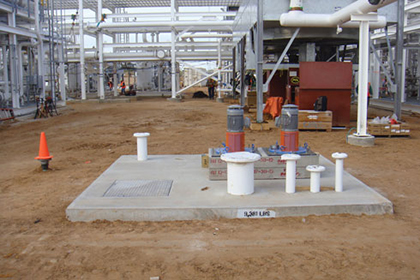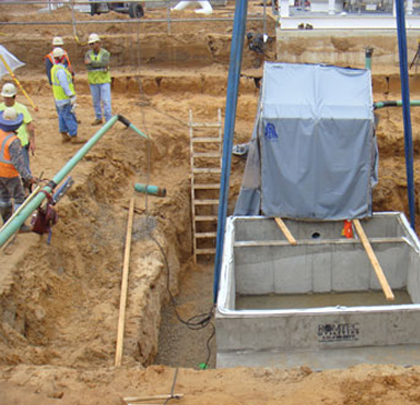Romtec Utilities works with many high-profile industrial clients on a variety of pump and lift station projects. Currently, one of the biggest demands is for package pump stations configured for industrial stormwater. Many industrial facilities, especially those in oil and gas, are leaders in the management and treatment of stormwater and industrial process water. There are many terrific examples of industrial facility managers going above and beyond regulations to manage stormwater responsibly.
Each industrial client that Romtec Utilities has worked with is representative of a growing trend toward progressively addressing the environmental concerns of stormwater runoff. It’s valuable to recognize these efforts and to discuss the methodology behind how and why the efforts are succeeding.

AWARENESS IS KEY
Industrial stormwater awareness conceptually began in 1973 with the passage of the Federal Clean Water Act, which established the National Pollution Discharge Elimination System (NPDES), a division of the EPA. Initially, its focus was sewage overflow and containment systems. This was a justifiable starting place being that sewage is as unpleasant as it is unsanitary. Environmental concerns for chemical and debris runoff did not fully enter the stormwater picture until the 1990 Stormwater Amendments of the Clean Water Act.
There are two components of the 1990 amendments that play an important role in today’s stormwater management, sometimes called best management practices (BMPs). Stormwater management systems must include the best available technology (BAT) and best conventional pollutant control technology (BCT) to maximize economically feasible pollution management. While this is not an exact definition, Romtec Utilities’ experience in the industrial marketplace reveals that BAT and BCT are often economically maximized with packaged stormwater pump stations.

SIMPLE TECHNOLOGY BUT VITAL EXPERIENCE
The technology behind stormwater pump stations is fairly simple to understand. As a stormwater event—rain—occurs at an industrial site, the water flows over impervious surfaces to lower elevations while collecting contaminants and debris. The goal is to direct the water to a low point of the facility and collect it. From the collection point, the stormwater can be pumped or transported to and from treatment. Although the theory is simple, the engineering and design of these systems is sophisticated.
For the industrial customers of Romtec Utilities, sophisticated systems are an integral aspect of day-to-day operations. They understand the importance of utilizing industry experts to manufacture and operate their systems. The reason Romtec Utilities makes such a valuable partner on industrial stormwater projects is because each package stormwater lift station needs to be site specific. This is true in terms of the engineering and configuration and also in terms of the technical capabilities and the personnel of the customer.
To ensure that a stormwater lift station is truly site specific, Romtec Utilities provides industrial clients with full documentation of the packaged lift station that is tailored to the customer’s objectives and abilities. Expert documentation provides a clear outline of the project including an item-for-item breakdown of the supply and installation procedure. This is how industrial clients meet BAT and BCT requirements with today’s technology while saving large amounts of money.
The end result is a fully integrated and technologically superior stormwater pump station that helps industrial customers to meet their environmental goals. To demonstrate exactly how a typical Romtec Utilities project develops with an industrial customer it is beneficial to see a real world example of a company’s environmental goals being accomplished through this methodology.

THE AJAX GAS PLANT
The Ajax Gas Plant in Wheeler, Texas, is a terrific example in this industrial stormwater discussion. This plant owned by Enbridge Energy Partners is a natural gas processing and refining facility that is currently under construction. The Ajax plant is expected to be operational (on schedule) in early 2013, and one of the final systems installed was the Romtec Utilities supplied packaged stormwater pump station.
Romtec Utilities worked with Enbridge Energy Partners (EEP) and Audubon Engineering to engineer a package system to safely manage the stormwater at the plant. According to the EEP website, Enbridge is recognized as one of the Global 100 Most Sustainable Companies. EEP also distinguishes “Social Responsibility” as one of its core corporate values, which was affirmed with its approach to this pump station.
From the standpoint of design, this pump station illustrates the value placed on environmental responsibility by these companies. The engineering specifications proposed a rectangular precast concrete wet well, which can have implications on pump station construction.
For the Ajax Gas Plant, Enbridge and Audubon wanted to eliminate any possible points of weakness, so Romtec Utilities designed and cast the rectangular wet well as a monolithic 11-foot-tall (3.35 meters) vault. Large, concrete precast wet wells are not easy, but EEP and Audubon were committed to installing a packaged system that went above and beyond the best available technology (BAT) required. Choices like this one demonstrate EEP’s continuing efforts for lower environmental impacts.
The station was engineered with vertical sump pumps for industrial water applications. These pumps are intended to handle the suspended particles, like grit or hydrocarbons, that can wash into the system during a stormwater event. Additionally, the bottom slab of the wet well includes a weir wall near where the inlet line enters the well. The weir wall provides a semi-contained area for heavier particles to settle. The water then overflows the weir wall with fewer suspended particles.
Many industrial customers employ staff capable of designing, installing, and maintaining electrical systems. For EEP and Audubon, Romtec Utilities’ packaged approach allowed them to purchase the engineering and components they required while self-managing more familiar aspects, such as electrical controls. This approach provided a much more affordable pump station for the client. EEP chose to use those savings to have an extremely robust and failsafe system engineered.
Finally, all of the stormwater from this site gets pumped into a holding tank. The tank is then emptied into trucks which transport the water to an offsite treatment facility. With this type of stormwater plan, EEP installed a very reliable stormwater system at the Ajax Gas Plant. Romtec Utilities works with many industrial clients like EEP that are “leading the changes” of the new environmental climate.
LEADING BY EXAMPLE
This example demonstrates two important points. First, it shows that industrial clients are often willing to add cost to a project in order to ensure its long-term environmental protection benefits. Second, the example shows that, even while adding some costs, a packaged pump station can be configured to utilize strengths within the client’s organization to reduce the overall price. These qualities are well within the requirements for BAT and BCT.
From the perspective of Romtec Utilities, the climate of industrial stormwater is changing. Industrial companies are quickly becoming the leaders in this field not just in terms of compliance but by actually spurring its development. The great news is that not only is pump station technology reliable and proven but it is also a tremendously affordable option, making pump stations a feasible solution for a wide spectrum of companies. If there is an industrial stormwater concern, packaged pump stations are definitely worth a look. ■
_________________________________________________________________________
ABOUT THE AUTHOR
William Burt is the marketing coordinator at Romtec Utilities, Inc. He can be reached at 541.496.9678 or marcom@romtecutilites.com.
_________________________________________________________________________
MODERN PUMPING TODAY, April 2013
Did you enjoy this article?
Subscribe to the FREE Digital Edition of Modern Pumping Today Magazine!
![]()


